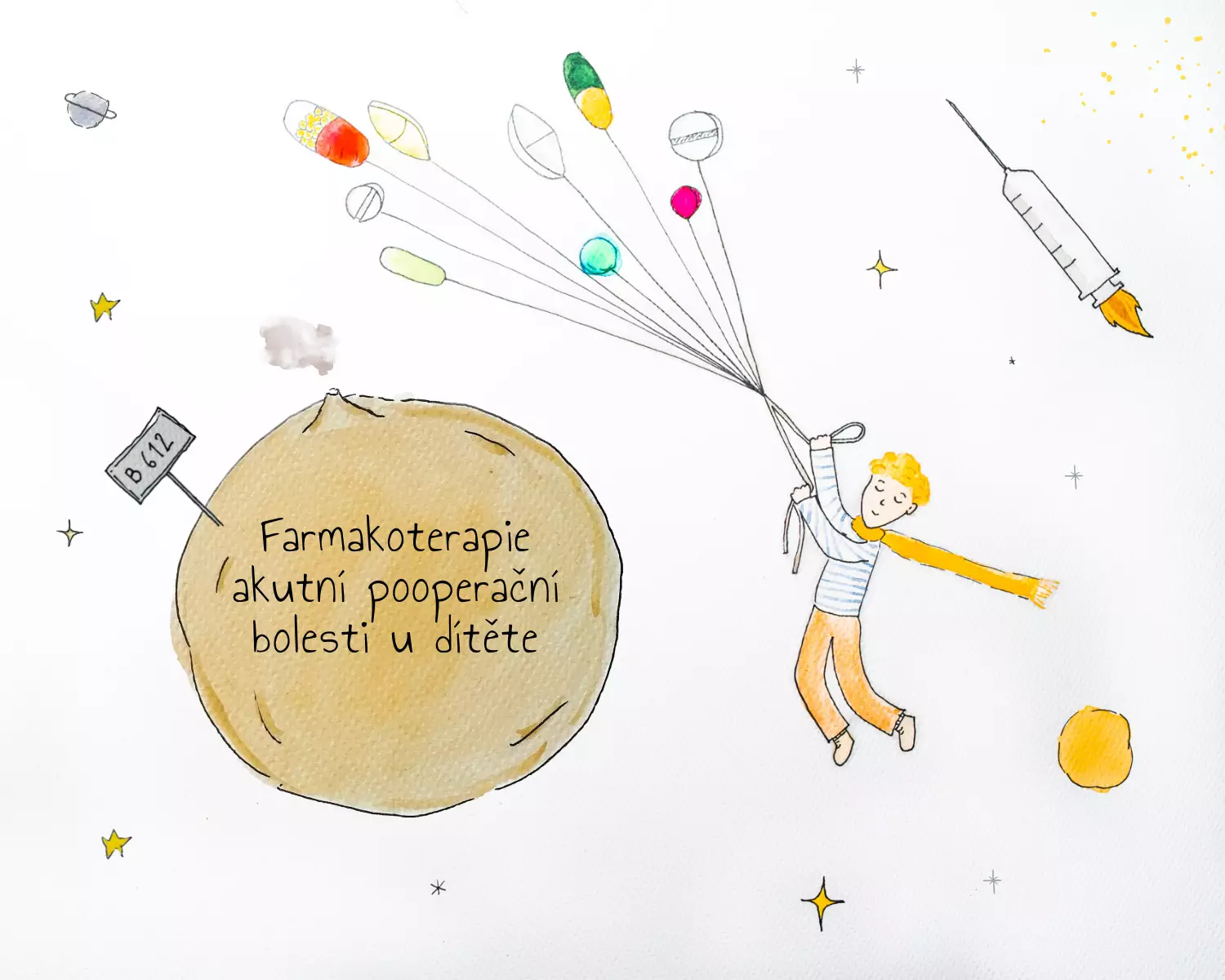Pharmacotherapy of acute postoperative pain in children
Pharmacotherapy of acute postoperative pain in children is an important aspect of perioperative care. In the context of analgotherapy, we try to prevent pain and not to react to its manifestations after a delay. It is important to remember that the paediatric patient is not a small adult and approaches to pharmacotherapy therefore differ. In our algorithm, we will focus on the use of multimodal analgesia, the appropriate choice of analgesic, but also, for example, the assessment of postoperative pain in pediatric patients.
Review
The algorithm of the portal Akutně.cz: Pharmacotherapy of acute postoperative pain in children introduces us to the management of pain in a child undergoing a surgical procedure during the entire perioperative process, from the examination of the of the child accompanied by parents in the anaesthesiology outpatient apartment and setting the analgesia plan, to analgesia in the standard wand. The importance of combining systemic multimodal analgesia and regional analgesia methods, in this case caudal blockade, is emphasised in the context of analgesia in the operating theatre with an extension to the postoperative period. The algorithm also deals with the issue of persistent pain. The necessity of pain monitoring is emphasized, both in the operating room and in the postanesthesia care unit and standard ward. In conclusion, the clarity of the algorithm and its educational benefit should be highlighted.
At the end of the review, I would like to mention a few key points regarding perioperative analgesia in the child:
Effective perioperative pain assesment in pediatric patients undergoing surgery is essential for better outcomes, comfort and patient satisfaction. Methods of nociception monioring are basied on: EEG curve assesment or, autonomic nervous systém effector assessment and/or a combination of these methods
Inadequate treatment of postoperative pain in children may originate from fear of serious complications from analgesics.
Initial perioperative pain management planning begins with a multidisciplinary meeting beetween the child, the patient's family, the surgeon, and the anesthesiologist.
Acute pain control regimens are individualized based on the type of surgery, age of patient, anticipated severity of postoperative pain, and patines or family expectations.
Multimodal strategies and regional anesthesia are useful additions to perioperatice analgesia.
Literature:
FRIZZELL, Kaela H.; CAVANAUGH, Priscilla K.; HERMAN, Martin J. Pediatric perioperative pain management. Orthopedic Clinics, 2017, 48.4: 467-480.
SABOURDIN, Nada; CONSTANT, Isabelle. Monitoring of analgesia level during general anesthesia in children. Current Opinion in Anaesthesiology, 2022, 35.3: 367-373.
Sources
ŠVIHOVEC, Jan, Jan BULTAS, Pavel ANZENBACHER, Jaroslav CHLÁDEK, Jan PŘÍBORSKÝ, Jiří SLÍVA a Martin VOTAVA. Farmakologie. Praha: GRADA Publishing, 2018. ISBN 978-80-247-5558-8.
ŠÍPEK, J. a V. MIXA. Současný pohled na kaudální epidurální blokády u dětí a jejich komplikace. Anesteziologie a intenzivní medicína [online]. 2016, 27(2), 78-86 [cit. 2023-05-15]. Available at: https://www.aimjournal.cz/artkey/aim-201602-0004_current-opinion-on-caudal-epidural-blockade-and-its-complications-in-children.php
KALOUSOVÁ, Jana, Blanka ROUSKOVÁ, Daniela PACHMANNOVÁ a Jitka STÝBLOVÁ. Bolest u dětí: hodnocení a některé způsoby léčby. Pediatrie pro praxi [online]. 2008, 9(1), 7-11 [cit. 2023-05-15]. Available at: https://www.pediatriepropraxi.cz/artkey/ped-200801-0002_Bolest_u_deti_hodnoceni_a_nektere_zpusoby_lecby.php
MIXA, Vladimír. Současný pohled na anestezii dětí. Pediatrie pro praxi [online]. 2012, 13(2), 103-106 [cit. 2023-05-15]. Available at: https://www.pediatriepropraxi.cz/artkey/ped-201202-0009_Soucasny_pohled_na_anestezii_deti.php
GAI, Nan, Basem NASER, Jacqueline HANLEY, Arie PELIOWSKI, Jason HAYES a Kazuyoshi AOYAMA. A practical guide to acute pain management in children. Journal of anestehesia [online]. 2020, 34(3), 421-433 [cit. 2023-05-15]. Available at: https://pubmed.ncbi.nlm.nih.gov/32236681/
ABDULLAYEV, Ruslan, Oznur ULUDAG a Bulent CELIK. Analgesia Nociception Index: assesment of acute postoperative pain. Brazilian journal of anesthesiology [online]. 2019, 69(4), 396-402 [cit. 2023-05-15]. Available at: https://pubmed.ncbi.nlm.nih.gov/31399197/
KŘIKAVA, Ivo, Viktor KUBRICHT, Jan LEJČKO, Jiří MÁLEK, Pavel ŠEVČÍK a Petr ŠTOURAČ. Doporučený postup - Léčba akutní pooperační bolesti [online]. 2022 [cit. 2023-05-15]. Available at: https://www.prolekare.cz/en/journals/anaesthesiology-and-intensive-care-medicine/2022-2-10/doporuceny-postup-lecba-akutni-pooperacni-bolesti-130942. Doporučený postup. ČSARIM.
Learning targets
2. After going through the algorithm, the student will know the methods of objective evaluation of pain intensity, including those specific to pain assesment in children.
3. The student will learn the basic principles of multimodal analgesia in children.
Key points
2. Children do not have a reduced perception of pain compared to adults, the experience of pain can leave a negative memory trace.
3. The effect of analgesic therapy needs to be reevaluated and responded to appropriately.





